2023.04.DD - Total Guitar - Inside The Slash Les Paul Collection
2 posters
Page 1 of 1
 2023.04.DD - Total Guitar - Inside The Slash Les Paul Collection
2023.04.DD - Total Guitar - Inside The Slash Les Paul Collection
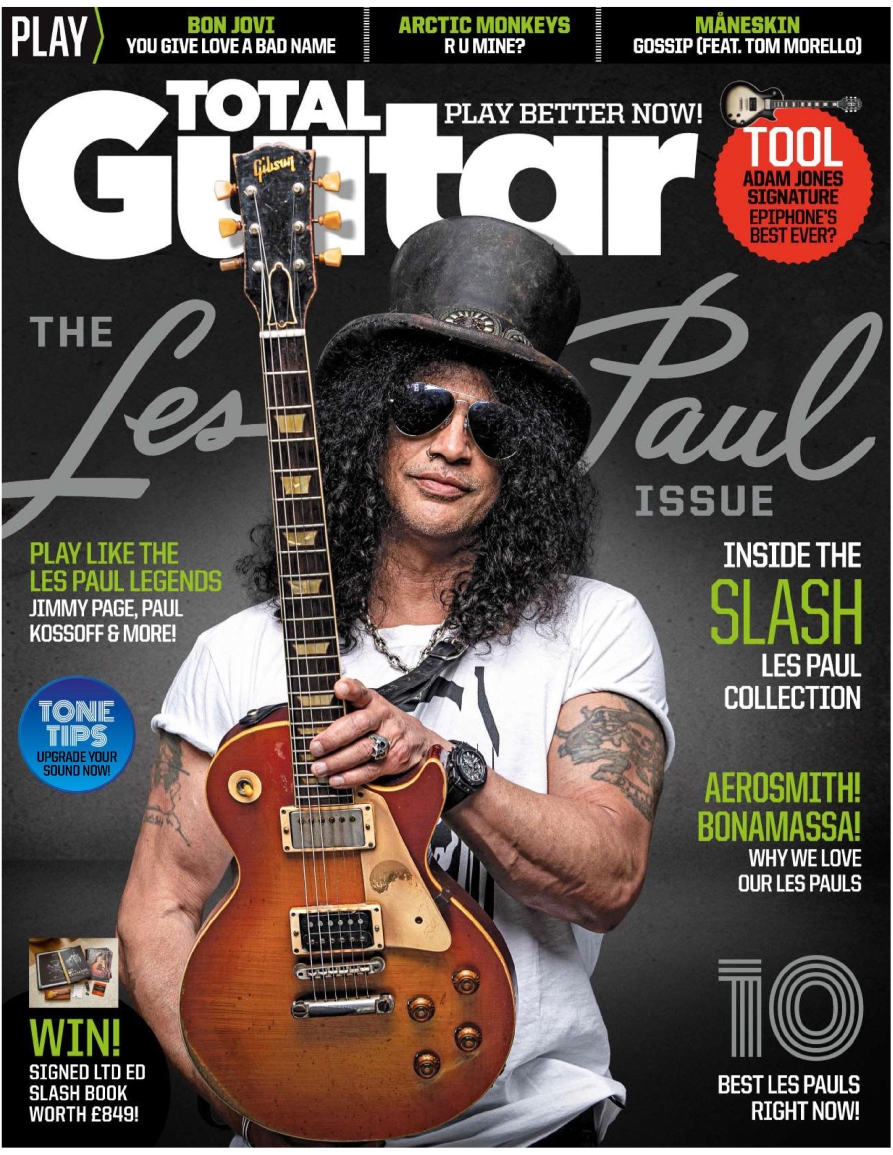
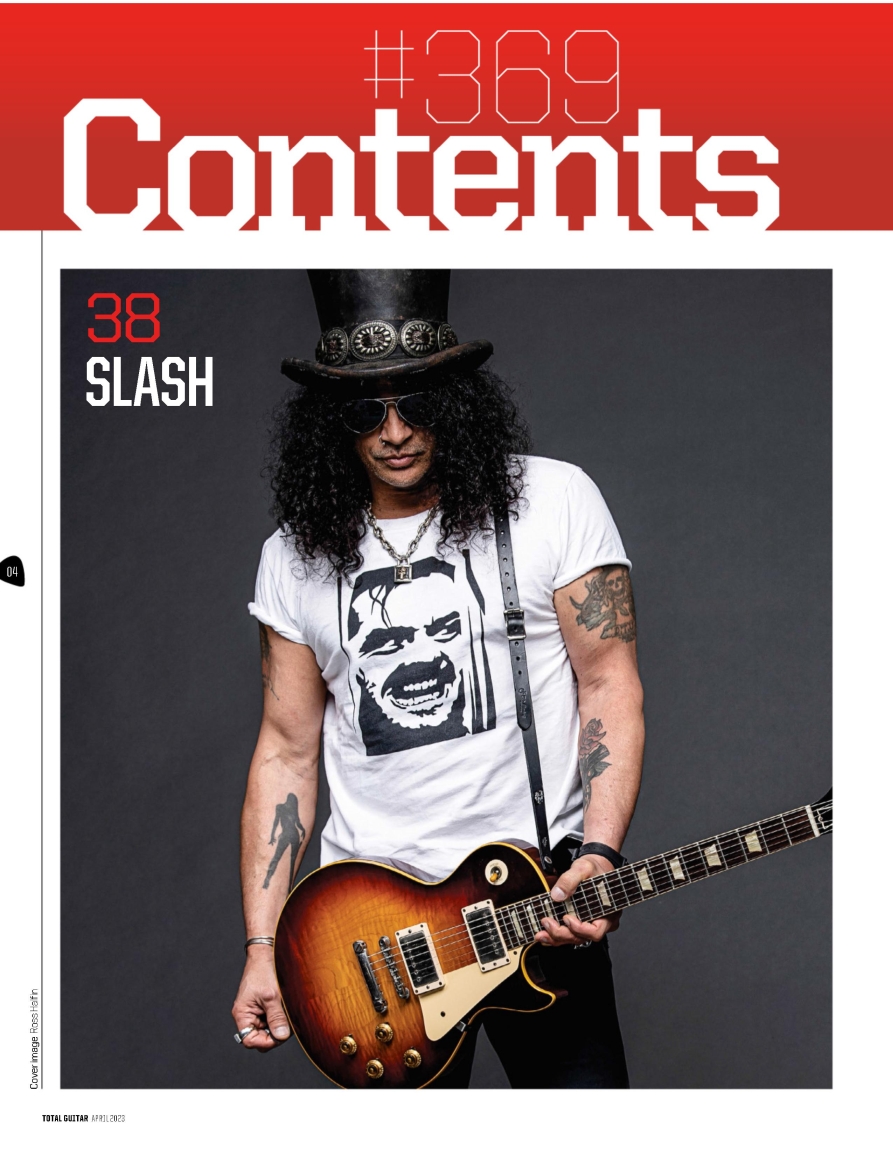
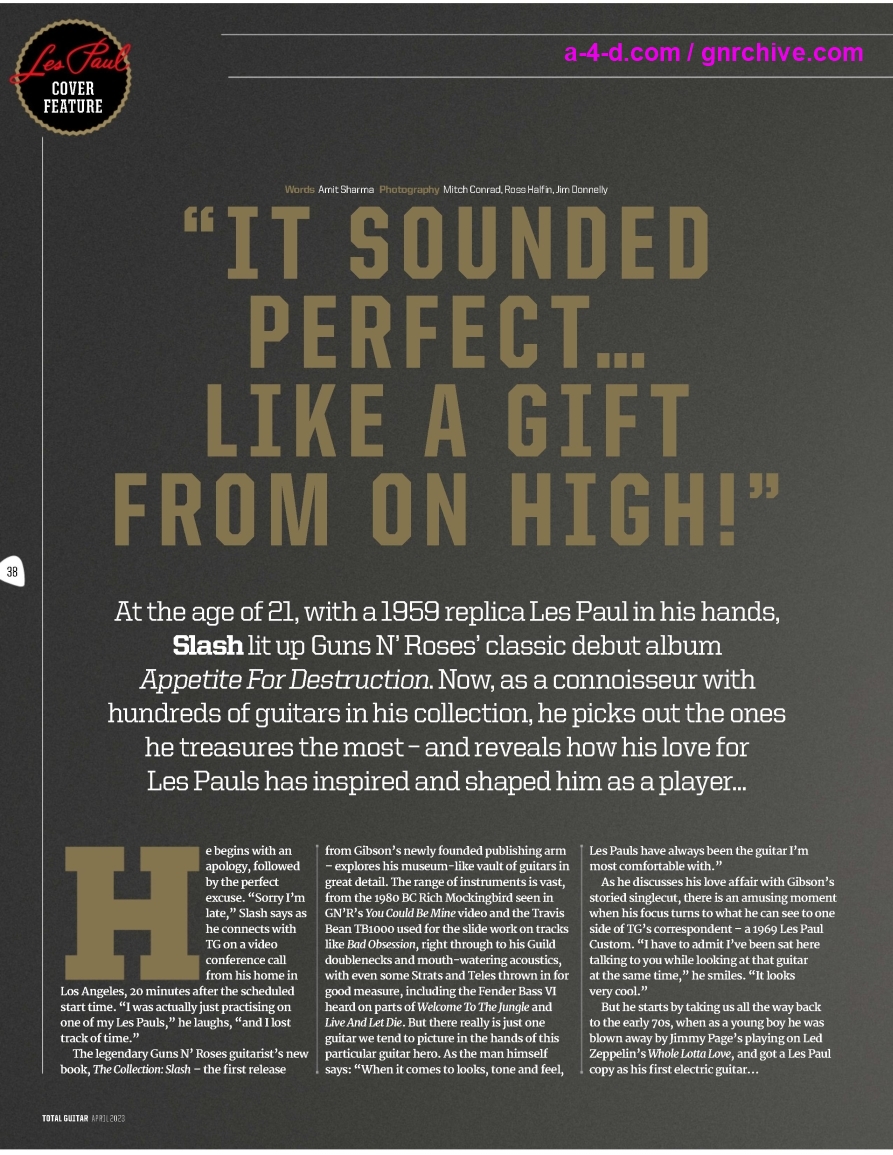


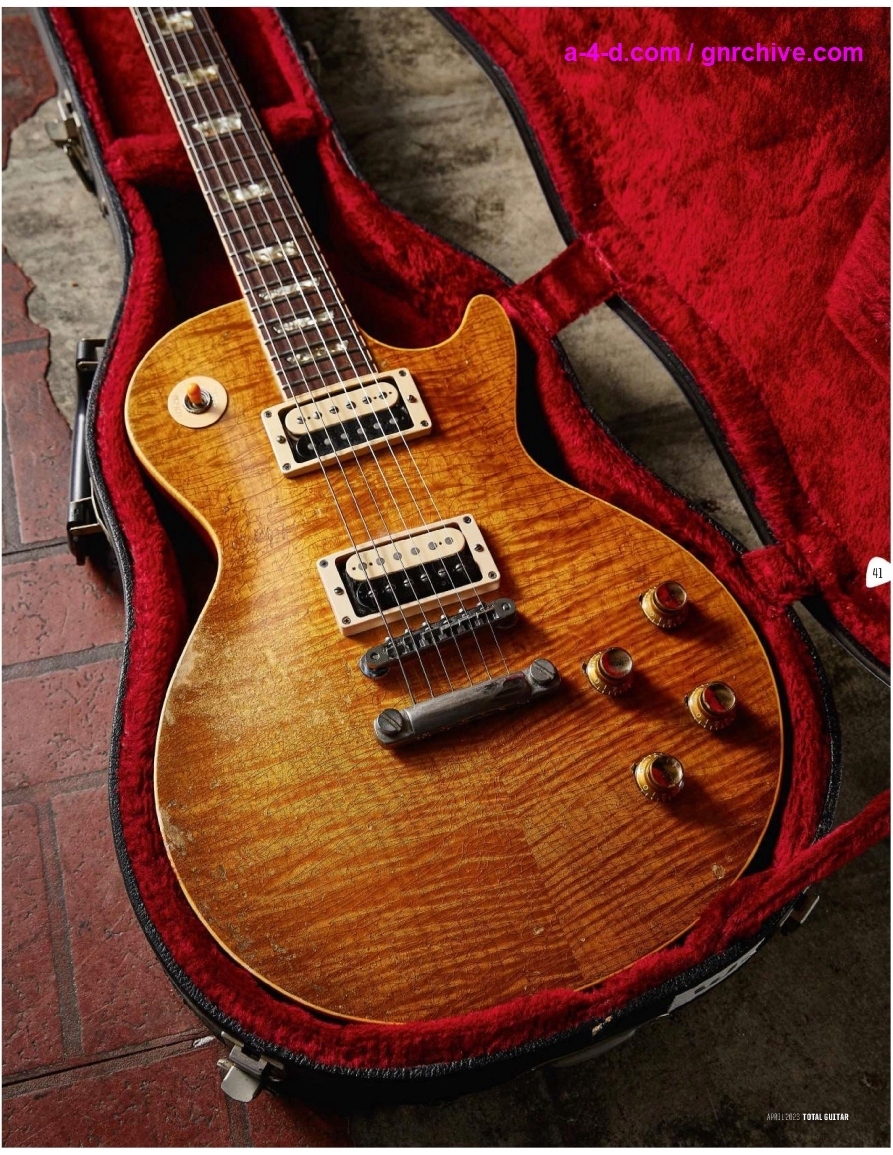
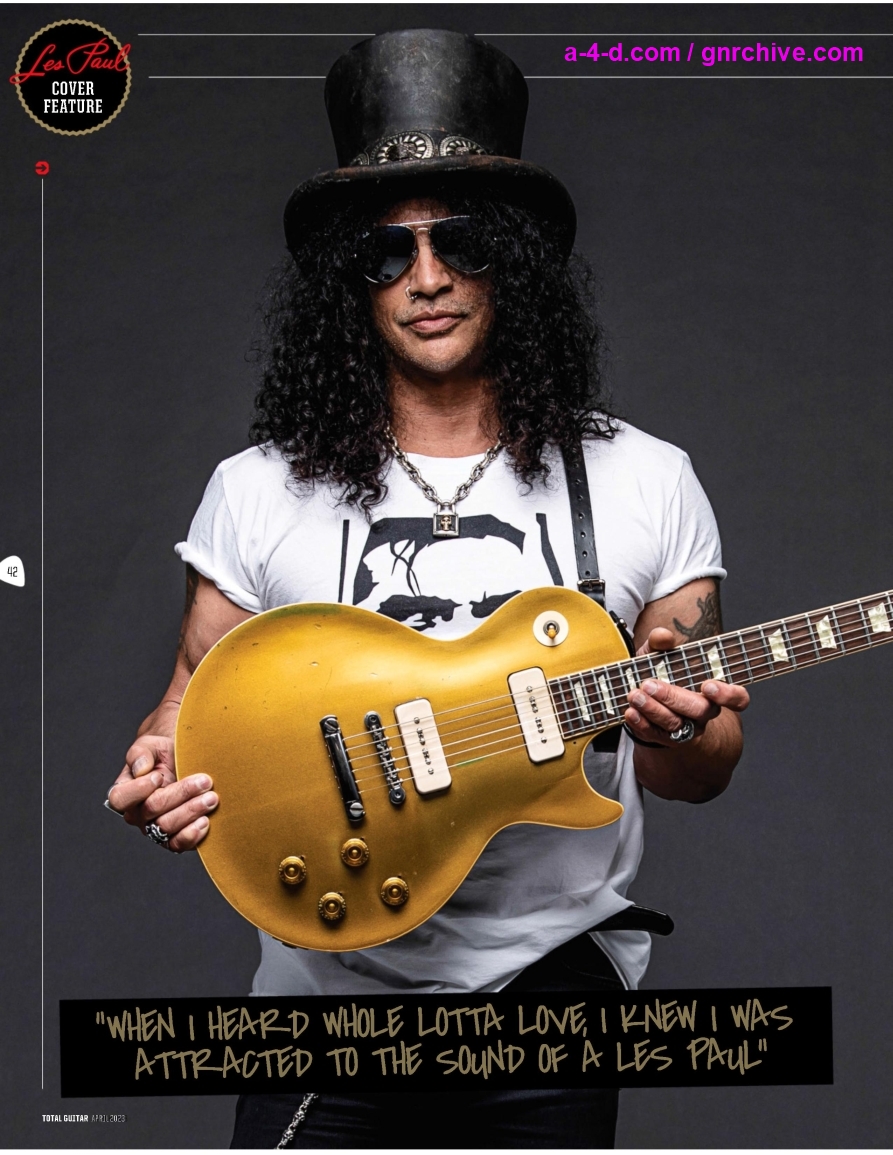
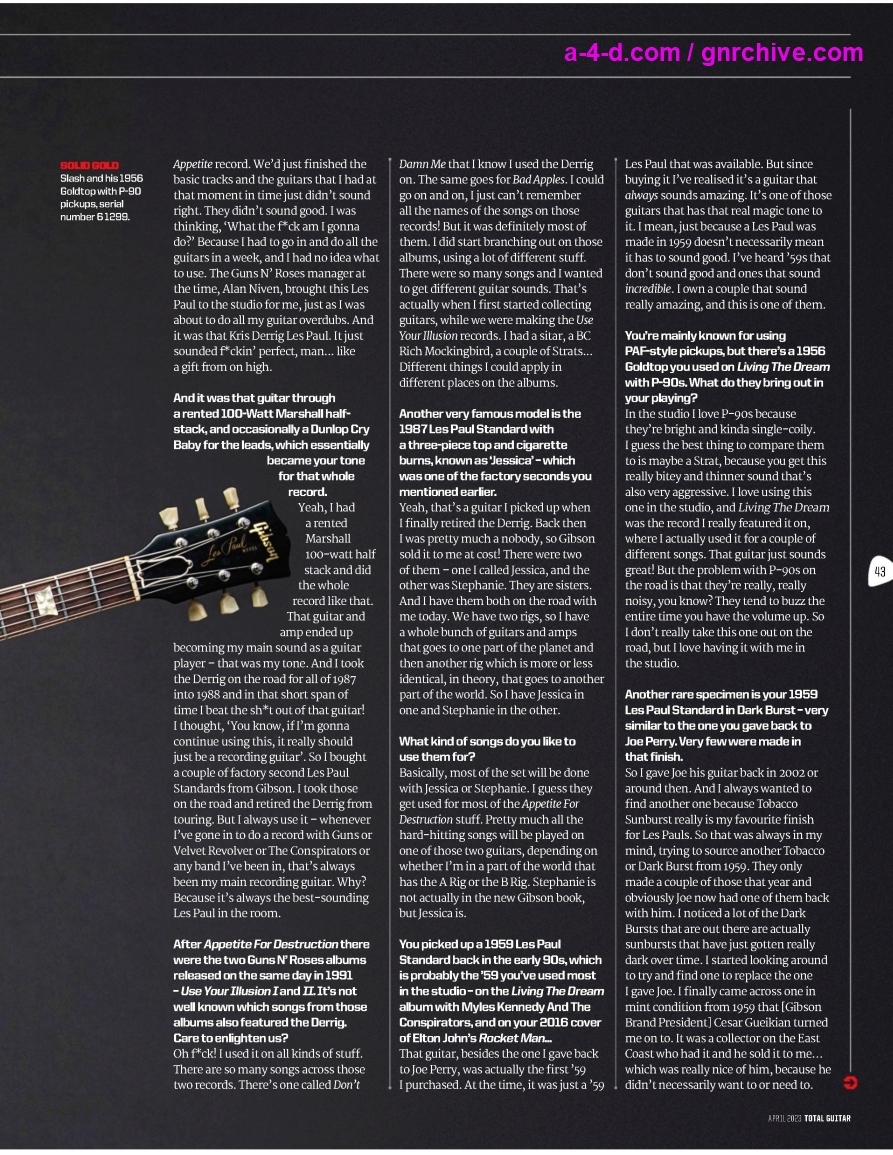
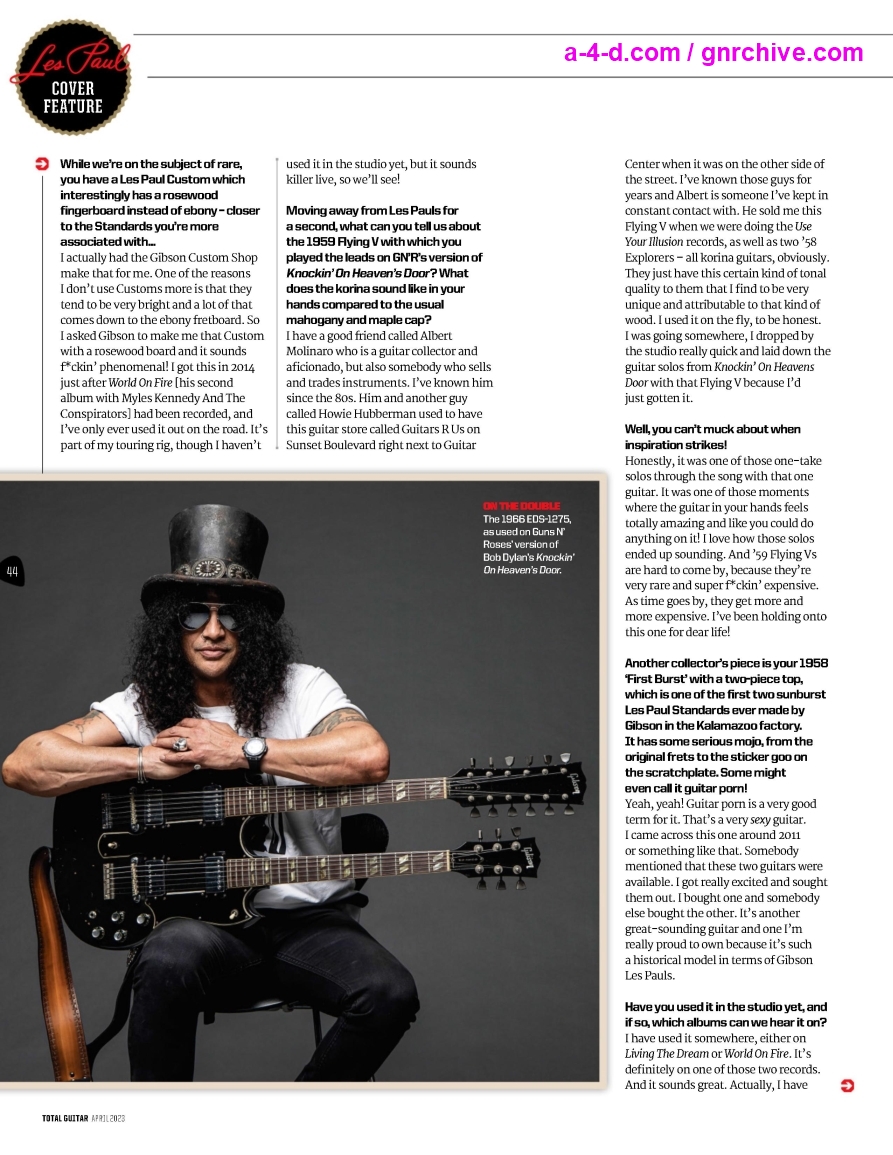
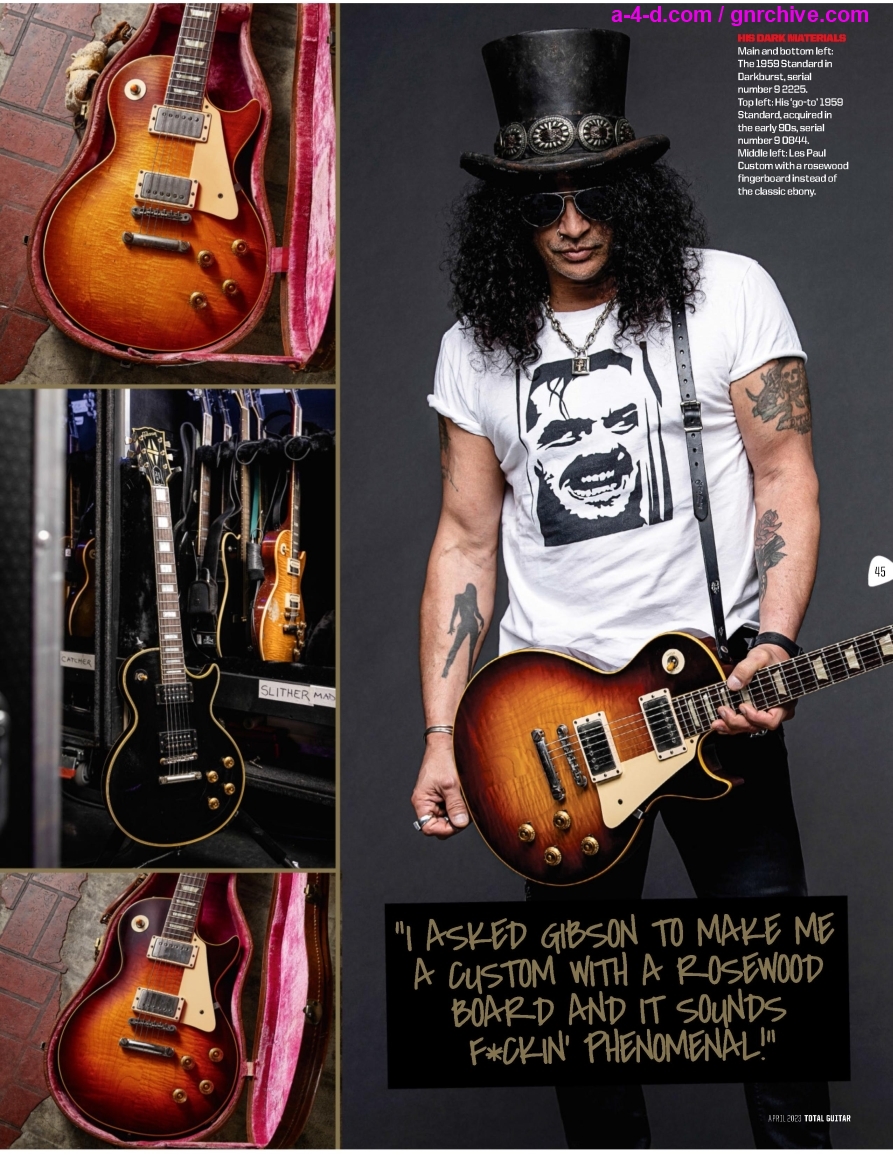
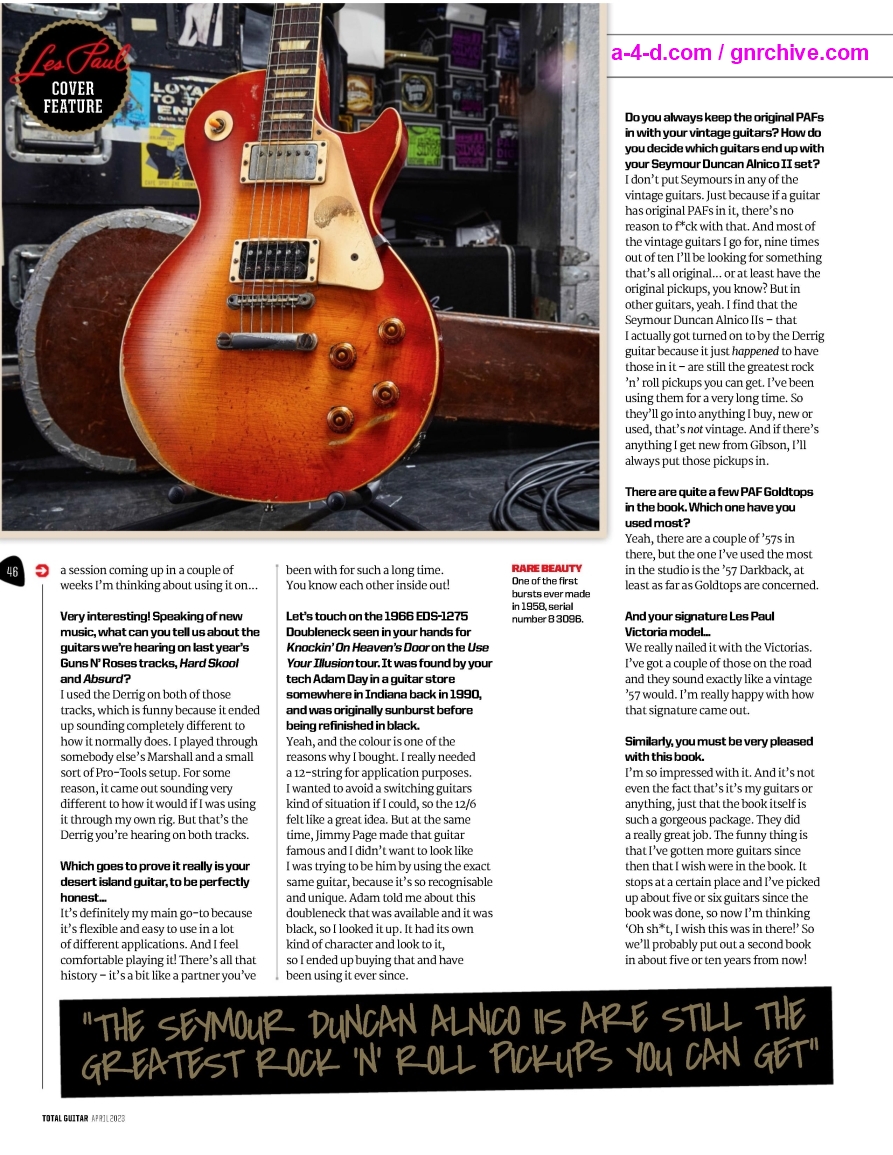
Transcript:
-----------------
“IT SOUNDED PERFECT... LIKE A GIFT FROM ON HIGH!”
At the age of 21, with a 1959 replica Les Paul in his hands, Slash lit up Guns N’ Roses’ classic debut album Appetite For Destruction. Now, as a connoisseur with hundreds of guitars in his collection, he picks out the ones he treasures the most — and reveals how his love for Les Pauls has inspired and shaped him as a player...
Words: Amit Sharma
Photography: Mitch Conrad, Ross Halfin, Jim Donnelly
He begins with an apology, followed by the perfect excuse. “Sorry I’m late,” Slash says as he connects with TG on a video conference call from his home in Los Angeles, 20 minutes after the scheduled start time. “I was actually just practising on one of my Les Pauls,” he laughs, “and I lost track of time.”
The legendary Guns N’ Roses guitarist’s new book, The Collection: Slash - the first release from Gibson’s newly founded publishing arm - explores his museum-like vault of guitars in great detail. The range of instruments is vast, from the 1980 BC Rich Mockingbird seen in GN’R’s You Could Be Mine video and the Travis Bean TB1000 used for the slide work on tracks like Bad Obsession, right through to his Guild doublenecks and mouth-watering acoustics, with even some Strats and Teles thrown in for good measure, including the Fender Bass VI heard on parts of Welcome To The Jungle and Live And Let Die. But there really is just one guitar we tend to picture in the hands of this particular guitar hero. As the man himself says: “When it comes to looks, tone and feel, Les Pauls have always been the guitar I’m most comfortable with.”
As he discusses his love affair with Gibson’s storied singlecut, there is an amusing moment when his focus turns to what he can see to one side of TG’s correspondent - a 1969 Les Paul Custom. “I have to admit I’ve been sat here talking to you while looking at that guitar at the same time,” he smiles. “It looks very cool.”
But he starts by taking us all the way back to the early 70s, when as a young boy he was blown away by Jimmy Page’s playing on Led Zeppelin’s Whole Lotta Love, and got a Les Paul copy as his first electric guitar...
Do you remember the exact moment you realised these magical Les Pauls would be your instrument of choice?
They are definitely magical instruments, but that’s actually a complicated question. I think all guitar players, or at least most of us, start off by trying to find the instrument we’re most comfortable with. We all go through that period of trial and error. I think I ended up with the Les Paul because the first electric guitar I ever got was a Les Paul copy made by a company called Memphis Guitars. So I just naturally gravitated to a Les Paul not knowing that much about guitar sounds at the time. I really didn’t have any experience or any real knowledge of what everybody was doing or about equipment in general. But it seemed like I was attracted to what I thought a Les Paul sounded like.
Which players had you seen holding a Les Paul at this early stage in your guitar journey?
There were a few guys who influenced me when it came to playing Les Pauls. I’d seen Eric Clapton holding one, as well as Jimmy Page, Keith Richards, Billy Gibbons... A lot of players who had a great sound using those guitars. I specifically remember hearing Whole Lotta Love from Led Zeppelin II when I was seven years old. And I attributed that sound — from what I felt was the coolest record I’d ever heard at that point in my life - to the Les Paul. Still, to this day, I’d say it’s one of the coolest records ever made. And I knew it was a Les Paul making those guitar tones because I saw pictures of Jimmy Page holding one - so that’s what made me associate the Les Paul with that kind of sound. Looking back now, I think that connection was pretty accurate! So I knew I was attracted to the sound of a Les Paul. I had that copy for a while and eventually it broke. I went through a myriad of different guitars to see what they sounded like, just exploring when it came to my tone. I ended up going back to the Les Paul and I’ve been with that ever since.
Jeff Beck is another player you’ve mentioned in the past - and while he was mainly known for playing a Strat, he used that Oxblood Les Paul in The Jeff Beck Group and on his earliest solo albums.
Yeah! Jeff Beck was another big one for me. I remember seeing the cover for [1975 album] Blow By Blow and thinking, ‘Okay, he uses a Les Paul too!’ Even though there’s a lot of Strat on that record as well, at the time I didn’t know any better!
Then, of course, there’s Joe Perry of Aerosmith, and that amazing story about you buying his 1959 Dark Burst Standard for eight grand in Japan, only to return it to him many years later as a birthday present. It had belonged to Duane Allman before Joe, and Eric Johnson even owned it at one point, so you scored quite a deal there.
Yeah, Duane and Eric owned it too, which is crazy! I was in Japan when I got the phone call from the office in LA saying that there was a guy who had a guitar I might be interested in. I was a big fan of Aerosmith and I remember the Live/Bootleg record had a couple of pictures of a Les Paul that looked different. It wasn’t your typical red sunburst finish. I thought it was just really faded and beaten up, because it had gone brown, but it was what we now call Tobacco Burst or Dark Burst. But anyway, I thought it was the coolest looking Les Paul I’d ever seen. So fast forward to Guns N’ Roses’ first tour of Japan and I got this phone call saying there’s this guitar available and that it was an old ’59 which had belonged to Joe Perry. I was like, ‘Well, get them to send over pictures’ - because I started to get pretty excited. I was wondering: could that possibly be that same guitar I know from the Bootleg record? When I got back to LA, in my mailbox was an envelope stuffed full of polaroids and it was that same f*ckin’ guitar! So I bought it for eight grand! The guy probably didn’t know what he had or just wanted to unload it. I kept that guitar for a long time and used it for various things. I used it in the November Rain video and some other stuff, but yeah, like you said, I eventually ended up giving it back to Joe.
So let’s talk about what is arguably your most iconic guitar - a 1959 replica built by American luthier Kris Derrig years before Gibson even made 1959 replicas. It had pride of place at the very forefront of Guns N’ Roses game-changing debut Appetite For Destruction, right next to Axl’s vocals.
That Derrig ’59 literally came in the eleventh hour when we were doing the Appetite record. We’d just finished the basic tracks and the guitars that I had at that moment in time just didn’t sound right. They didn’t sound good. I was thinking, ‘What the f*ck am I gonna do?’ Because I had to go in and do all the guitars in a week, and I had no idea what to use. The Guns N’ Roses manager at the time, Alan Niven, brought this Les Paul to the studio for me, just as I was about to do all my guitar overdubs. And it was that Kris Derrig Les Paul. It just sounded f*ckin’ perfect, man... like a gift from on high.
And it was that guitar through a rented 100-Watt Marshall half-stack, and occasionally a Dunlop Cry Baby for the leads, which essentially became your tone for that whole record.
Yeah, I had a rented Marshall 100-watt half stack and did the whole record like that. That guitar and amp ended up becoming my main sound as a guitar player - that was my tone. And I took the Derrig on the road for all of 1987 into 1988 and in that short span of time I beat the sh*t out of that guitar! I thought, ‘You know, if I’m gonna continue using this, it really should just be a recording guitar’. So I bought a couple of factory second Les Paul Standards from Gibson. I took those on the road and retired the Derrig from touring. But I always use it - whenever I’ve gone in to do a record with Guns or Velvet Revolver or The Conspirators or any band I’ve been in, that’s always been my main recording guitar. Why? Because it’s always the best-sounding Les Paul in the room.
After Appetite For Destruction there were the two Guns N’ Roses albums released on the same day in 1991 - Use Your Illusion I and II. It’s not well known which songs from those albums also featured the Derrig. Care to enlighten us?
Oh f*ck! I used it on all kinds of stuff. There are so many songs across those two records. There’s one called Don’t Damn Me that I know I used the Derrig on. The same goes for Bad Apples. I could go on and on, I just can’t remember all the names of the songs on those records! But it was definitely most of them. I did start branching out on those albums, using a lot of different stuff. There were so many songs and I wanted to get different guitar sounds. That’s actually when I first started collecting guitars, while we were making the Use Your Illusion records. I had a sitar, a BC Rich Mockingbird, a couple of Strats... Different things I could apply in different places on the albums.
Another very famous model is the 1987 Les Paul Standard with a three-piece top and cigarette burns, known as ‘Jessica’ - which was one of the factory seconds you mentioned earlier.
Yeah, that’s a guitar I picked up when I finally retired the Derrig. Back then I was pretty much a nobody, so Gibson sold it to me at cost! There were two of them - one I called Jessica, and the other was Stephanie. They are sisters. And I have them both on the road with me today. We have two rigs, so I have a whole bunch of guitars and amps that goes to one part of the planet and then another rig which is more or less identical, in theory, that goes to another part of the world. So I have Jessica in one and Stephanie in the other.
What kind of songs do you like to use them for?
Basically, most of the set will be done with Jessica or Stephanie. I guess they get used for most of the Appetite For Destruction stuff. Pretty much all the hard-hitting songs will be played on one of those two guitars, depending on whether I’m in a part of the world that has the A Rig or the B Rig. Stephanie is not actually in the new Gibson book, but Jessica is.
You picked up a 1959 Les Paul Standard back in the early 90s, which is probably the ’59 you’ve used most in the studio - on the Living The Dream album with Myles Kennedy And The Conspirators, and on your 2016 cover of Elton John’s Rocket Man...
That guitar, besides the one I gave back to Joe Perry, was actually the first ’59 I purchased. At the time, it was just a ’59 Les Paul that was available. But since buying it I’ve realised it’s a guitar that always sounds amazing. It’s one of those guitars that has that real magic tone to it. I mean, just because a Les Paul was made in 1959 doesn’t necessarily mean it has to sound good. I’ve heard ’59s that don’t sound good and ones that sound incredible. I own a couple that sound really amazing, and this is one of them.
You’re mainly known for using PAF-style pickups, but there’s a 1956 Goldtop you used on Living The Dream with P-90s. What do they bring out in your playing?
In the studio I love P—90s because they’re bright and kinda single-coily. I guess the best thing to compare them to is maybe a Strat, because you get this really bitey and thinner sound that’s also very aggressive. I love using this one in the studio, and Living The Dream was the record I really featured it on, where I actually used it for a couple of different songs. That guitar just sounds great! But the problem with P—90s on the road is that they’re really, really noisy, you know? They tend to buzz the entire time you have the volume up. So I don’t really take this one out on the road, but I love having it with me in the studio.
Another rare specimen is your 1959 Les Paul Standard in Dark Burst - very similar to the one you gave back to Joe Perry. Very few were made in that finish.
So I gave Joe his guitar back in 2002 or around then. And I always wanted to find another one because Tobacco Sunburst really is my favourite finish for Les Pauls. So that was always in my mind, trying to source another Tobacco or Dark Burst from 1959. They only made a couple of those that year and obviously Joe now had one of them back with him. I noticed a lot of the Dark Bursts that are out there are actually sunbursts that have just gotten really dark over time. I started looking around to try and find one to replace the one I gave Joe. I finally came across one in mint condition from 1959 that [Gibson Brand President] Cesar Gueikian turned me on to. It was a collector on the East Coast who had it and he sold it to me... which was really nice of him, because he didn’t necessarily want to or need to.
While we’re on the subject of rare, you have a Les Paul Custom which interestingly has a rosewood fingerboard instead of ebony - closer to the Standards you’re more associated with...
I actually had the Gibson Custom Shop make that for me. One of the reasons I don’t use Customs more is that they tend to be very bright and a lot of that comes down to the ebony fretboard. So I asked Gibson to make me that Custom with a rosewood board and it sounds f*ckin’ phenomenal! I got this in 2014 just after World On Fire [his second album with Myles Kennedy And The Conspirators] had been recorded, and I’ve only ever used it out on the road. It’s part of my touring rig, though I haven’t used it in the studio yet, but it sounds killer live, so we’ll see!
Moving away from Les Pauls for a second, what can you tell us about the 1959 Flying V with which you played the leads on GN’R’s version of Knockin’ On Heaven’s Door? What does the korina sound like in your hands compared to the usual mahogany and maple cap?
I have a good friend called Albert Molinaro who is a guitar collector and aficionado, but also somebody who sells and trades instruments. I’ve known him since the 80s. Him and another guy called Howie Hubberman used to have this guitar store called Guitars R Us on Sunset Boulevard right next to Guitar Center when it was on the other side of the street. I’ve known those guys for years and Albert is someone I’ve kept in constant contact with. He sold me this Flying V when we were doing the Use Your Illusion records, as well as two ’58 Explorers - all korina guitars, obviously. They just have this certain kind of tonal quality to them that I find to be very unique and attributable to that kind of wood. I used it on the fly, to be honest. I was going somewhere, I dropped by the studio really quick and laid down the guitar solos from Knockin’ On Heavens Door with that Flying V because I’d just gotten it.
Well, you can’t muck about when inspiration strikes!
Honestly, it was one of those one-take solos through the song with that one guitar. It was one of those moments where the guitar in your hands feels totally amazing and like you could do anything on it! I love how those solos ended up sounding. And ’59 Flying Vs are hard to come by, because they’re very rare and super f*ckin’ expensive. As time goes by, they get more and more expensive. I’ve been holding onto this one for dear life!
Another collector’s piece is your 1958 ‘First Burst’ with a two-piece top, which is one of the first two sunburst Les Paul Standards ever made by Gibson in the Kalamazoo factory. It has some serious mojo, from the original frets to the sticker goo on the scratchplate. Some might even call it guitar porn!
Yeah, yeah! Guitar porn is a very good term for it. That’s a very sexy guitar. I came across this one around 2011 or something like that. Somebody mentioned that these two guitars were available. I got really excited and sought them out. I bought one and somebody else bought the other. It’s another great-sounding guitar and one I’m really proud to own because it’s such a historical model in terms of Gibson Les Pauls.
Have you used it in the studio yet, and if so, which albums can we hear it on?
I have used it somewhere, either on Living The Dream or World On Fire. It's definitely on one of those two records. And it sounds great. Actually, I have a session coming up in a couple of weeks I’m thinking about using it on...
Very interesting! Speaking of new music, what can you tell us about the guitars we’re hearing on last year’s Guns N’ Roses tracks, Hard Skool and Absurd?
I used the Derrig on both of those tracks, which is funny because it ended up sounding completely different to how it normally does. I played through somebody else’s Marshall and a small sort of Pro-Tools setup. For some reason, it came out sounding very different to how it would if I was using it through my own rig. But that’s the Derrig you’re hearing on both tracks.
Which goes to prove it really is your desert island guitar, to be perfectly honest...
It’s definitely my main go-to because it’s flexible and easy to use in a lot of different applications. And I feel comfortable playing it! There’s all that history - it’s a bit like a partner you’ve been with for such a long time. You know each other inside out!
Let’s touch on the 1966 EDS-1275 Doubleneck seen in your hands for Knockin’ On Heaven's Door on the Use Your Illusion tour. It was found by your tech Adam Day in a guitar store somewhere in Indiana back in 1990, and was originally sunburst before being refinished in black.
Yeah, and the colour is one of the reasons why I bought. I really needed a 12-string for application purposes. I wanted to avoid a switching guitars kind of situation if I could, so the 12/6 felt like a great idea. But at the same time, Jimmy Page made that guitar famous and I didn’t want to look like I was trying to be him by using the exact same guitar, because it’s so recognisable and unique. Adam told me about this doubleneck that was available and it was black, so I looked it up. It had its own kind of character and look to it, so I ended up buying that and have been using it ever since.
Do you always keep the original PAFs in with your vintage guitars? How do you decide which guitars end up with your Seymour Duncan Alnico II set?
I don’t put Seymours in any of the vintage guitars. Just because if a guitar has original PAFs in it, there’s no reason to f*ck with that. And most of the vintage guitars I go for, nine times out of ten I’ll be looking for something that’s all original... or at least have the original pickups, you know? But in other guitars, yeah. I find that the Seymour Duncan Alnico IIs - that I actually got turned on to by the Derrig guitar because it just happened to have those in it - are still the greatest rock ’n’ roll pickups you can get. I’ve been using them for a very long time. So they’ll go into anything I buy, new or used, that’s not vintage. And if there’s anything I get new from Gibson, I’ll always put those pickups in.
There are quite a few PAF Goldtops in the book. Which one have you used most?
Yeah, there are a couple of ’57s in there, but the one I’ve used the most in the studio is the ’57 Darkback, at least as far as Goldtops are concerned.
And your signature Les Paul Victoria model...
We really nailed it with the Victorias. I’ve got a couple of those on the road and they sound exactly like a vintage ’57would. I’m really happy with how that signature came out.
Similarly, you must be very pleased with this book.
I’m so impressed with it. And it’s not even the fact that’s it’s my guitars or anything, just that the book itself is such a gorgeous package. They did a really great job. The funny thing is that I’ve gotten more guitars since then that I wish were in the book. It stops at a certain place and I’ve picked up about five or six guitars since the book was done, so now I’m thinking ‘Oh sh*t, I wish this was in there!’ So we’ll probably put out a second book in about five or ten years from now!
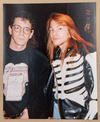
Blackstar- ADMIN
- Posts : 13787
Plectra : 90377
Reputation : 101
Join date : 2018-03-17
 Re: 2023.04.DD - Total Guitar - Inside The Slash Les Paul Collection
Re: 2023.04.DD - Total Guitar - Inside The Slash Les Paul Collection
"I used the Derrig on both of those tracks, which is funny because it ended up sounding completely different to how it normally does. I played through somebody else’s Marshall and a small sort of Pro-Tools setup. For some reason, it came out sounding very different to how it would if I was using it through my own rig. But that’s the Derrig you’re hearing on both tracks."
This part is interesting.
I assume he recorded his guitars at Axl's house - weren't there rumours about that? If so, why didn't he record at his own home to have his own gear? It seems unlike Slash to compromise on his guitars.
Maybe he wanted to do it at Axl's to make it more collaborative? Be together when they recorded (although Slash never likes others around when he records), for feedback from Axl?
Or maybe Axl insisted and didn't want to send songs to Slash, similar to when Bumblefoot recorded his parts? Out of fear of leaks. If so, did Slash get plenty of time to come up with his parts? Did he know the songs from before (I am sure he did)?
This part is interesting.
I assume he recorded his guitars at Axl's house - weren't there rumours about that? If so, why didn't he record at his own home to have his own gear? It seems unlike Slash to compromise on his guitars.
Maybe he wanted to do it at Axl's to make it more collaborative? Be together when they recorded (although Slash never likes others around when he records), for feedback from Axl?
Or maybe Axl insisted and didn't want to send songs to Slash, similar to when Bumblefoot recorded his parts? Out of fear of leaks. If so, did Slash get plenty of time to come up with his parts? Did he know the songs from before (I am sure he did)?

Soulmonster- Band Lawyer
-

Posts : 15854
Plectra : 76906
Reputation : 831
Join date : 2010-07-06
 Re: 2023.04.DD - Total Guitar - Inside The Slash Les Paul Collection
Re: 2023.04.DD - Total Guitar - Inside The Slash Les Paul Collection
Yes, the rumour started from this post on facebook on April 26, 2019:
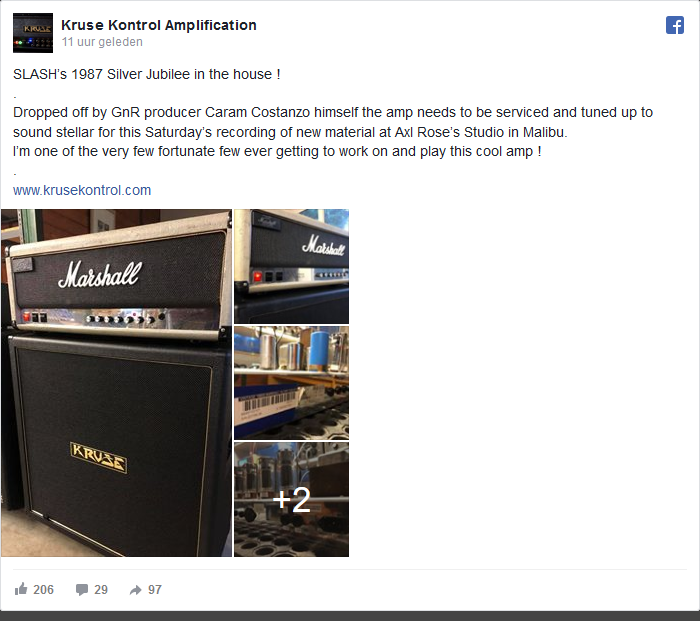
And Slash confirmed it a month later:
Meltdown: There’s rumors that you were at Axl’s house a few weeks ago or something. Can you comment on anything about that?
Slash: It’s funny, because there was a rumor that I was over there, yeah, and before I’d even been there. [...] It was a pain in the ass and annoying. But I’m excited about what we’ve got going on and everything, so it’s gonna be cool. It's freakin' awesome.
https://www.a-4-d.com/t3942-2019-05-28-wrif-detroit-talkin-rock-with-meltdown-interview-with-slash-audio
*
The impression from the facebook post is that it was Slash's amp - or maybe it was just the same model?
But then, in later interviews, Slash said that Hard Skool and Absurd were recorded during lockdown (around April 2020), so after the village leaks. However, Hard Skool was soundchecked in Mexico in March 2020, which could mean that there was already a studio recording.

And Slash confirmed it a month later:
Meltdown: There’s rumors that you were at Axl’s house a few weeks ago or something. Can you comment on anything about that?
Slash: It’s funny, because there was a rumor that I was over there, yeah, and before I’d even been there. [...] It was a pain in the ass and annoying. But I’m excited about what we’ve got going on and everything, so it’s gonna be cool. It's freakin' awesome.
https://www.a-4-d.com/t3942-2019-05-28-wrif-detroit-talkin-rock-with-meltdown-interview-with-slash-audio
*
The impression from the facebook post is that it was Slash's amp - or maybe it was just the same model?
But then, in later interviews, Slash said that Hard Skool and Absurd were recorded during lockdown (around April 2020), so after the village leaks. However, Hard Skool was soundchecked in Mexico in March 2020, which could mean that there was already a studio recording.

Blackstar- ADMIN
- Posts : 13787
Plectra : 90377
Reputation : 101
Join date : 2018-03-17
 Similar topics
Similar topics» 2023.05.DD - Guitar Player - Slash: The Collection
» 2009.08.14 - L.A. Weekly - Guitar Legends: Slash Remembers Friend and Mentor Les Paul, A Total Fuckin' Maverick
» 2003.06.DD - Total Guitar - GN'R: The Inside Story
» 2022.03.DD - Total Guitar - Slash: The Return Of The Guitar Hero
» 2005.08.DD - Total Guitar - Guitar Summit '05 (Slash)
» 2009.08.14 - L.A. Weekly - Guitar Legends: Slash Remembers Friend and Mentor Les Paul, A Total Fuckin' Maverick
» 2003.06.DD - Total Guitar - GN'R: The Inside Story
» 2022.03.DD - Total Guitar - Slash: The Return Of The Guitar Hero
» 2005.08.DD - Total Guitar - Guitar Summit '05 (Slash)
Page 1 of 1
Permissions in this forum:
You cannot reply to topics in this forum|
|
|

